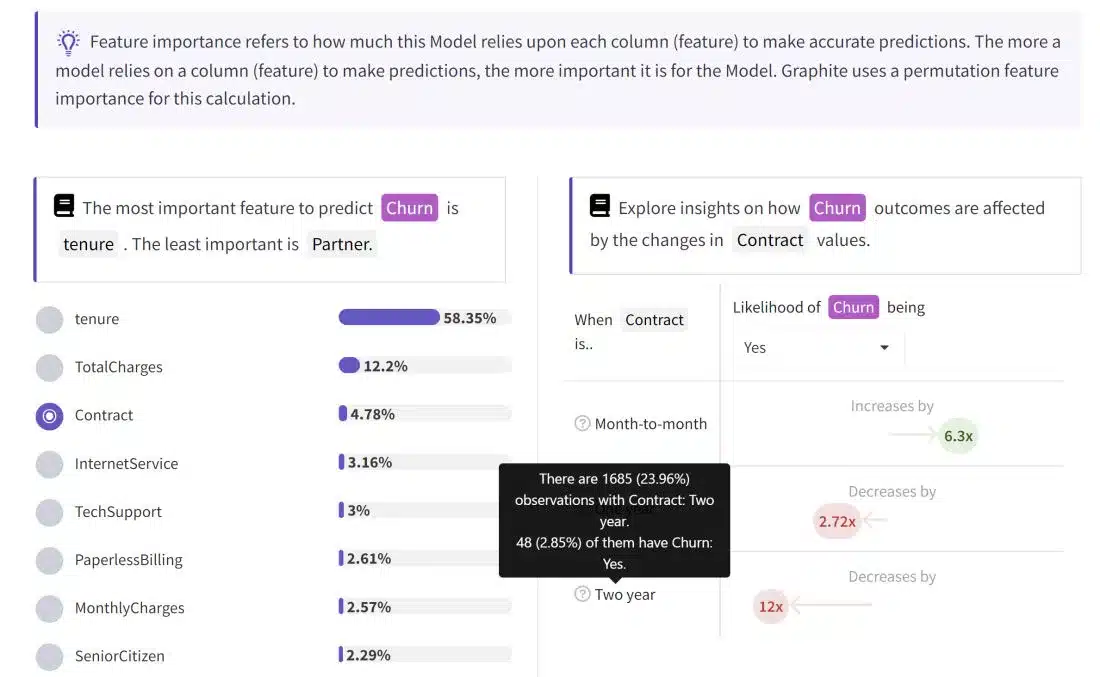Predicting Churn for Digital Agencies: A Comprehensive Guide
Keeping your digital agency’s customers happy is key for your success. You need to maintain, and grow, your loyal and satisfied client base. Clients sometimes decide to part ways, however, which may leave your agency wondering why and how to prevent it in the future. You need to be able to understand your customer churn prediction, so you can mitigate it, and work to keep your customers. A predictive churn model can bolster your efforts, so you can manage your customer churn rate. This comprehensive guide outlines the concept of churn, its importance in the digital agency landscape, and how data analysis can help predict and prevent churn. Effective churn prediction is essential for your digital agency to maintain your customer base and improve customer retention rates.
Understanding Churn in Digital Agencies
It’s important to understand what churn actually means in the context of your digital agency. Your churn rate is the percentage of clients who discontinue your engagement with your agency within a specific period, such as a month or a year. Your customer churn rates are an essential metric that your agency can track to measure client retention and identify areas for improvement. Customer churn prediction models can help your agency anticipate and mitigate lost revenue. A predictive churn model can help you plan for the worst, and aim for the best. A customer churn prediction model helps you spot areas of concern, so you can better manage them, to prevent churn.
Prevent Customer Churn
Your churn rate is not just a number. Your churn rate represents the loss of potential revenue and the erosion of client relationships. When clients churn, it can be an indication of dissatisfaction, changes in business needs, or your competition offering better services. Understanding churn and its underlying causes is vital for your digital agency to thrive in a highly competitive market. Churn analysis can provide valuable insights into customer behavior and help your agency develop strategies to prevent customer churn.
Defining Your Churn Rate
Your churn rate is calculated by dividing the number of clients who left during a given period by the total number of clients at the beginning of that period. For example, if your agency starts the month with 100 clients and loses 10 clients, the churn rate for that month would be 10%. Monitoring and analyzing churn rate data, your digital agency can gain valuable insights into client behavior and trends. Churn trends can help your agency identify patterns and take proactive measures to retain customers.
Churn rates can vary across different industries and agency types. Factors including the nature of services provided, client expectations, and market dynamics can influence your churn rate. Your agency should benchmark your churn rate against industry standards and competitors to gauge your performance and identify areas of improvement. High churn rates can be particularly concerning and may require immediate attention. High churn rates can indicate bigger issues too, and a predictive model can help you identify problems before they take root.

Importance of Churn Prediction
Churn prediction plays an important role in ensuring the long-term survival and growth of your digital agency. Identifying potential churners in advance, your agency can take proactive measures to retain clients and prevent future revenue loss. Moreover, churn prediction enables your agency to allocate resources more strategically, focusing on high-risk clients while also nurturing and upselling loyal customers. A successful churn prediction strategy can significantly affect your agency’s bottom line. A successful churn prediction model helps you prevent customer churn, predict whether and when a new customer may churn, and helps you identify a client who may be high risk. Your churn prediction model can also help you identify your most active customers, analyze individual customers, and discover an additional potential revenue source. Your customer churn model, combined with your BI tool, can help you better service your client base in more and more ways. And, you don’t need a data science team to create and benefit from a customer churn model.
What Does Churn Prediction Involve?
Churn prediction involves analyzing various data points and data types. These can include customer service interactions, data from your customer success manager platform, or customer success manager teams, client behavior, engagement metrics, and customer feedback. Using advanced analytics, a machine learning model, and machine learning algorithms, your agency can identify patterns and indicators that signal potential churn. These insights empower your agency to develop targeted retention strategies, such as personalized communication, service enhancements, or tailored offers, to mitigate churn risk and strengthen your client relationships. Customer churn analysis can help your agency understand the root causes of client attrition and develop effective strategies to address them. You can build proactive retention efforts and enhance customer engagement to prevent churn, or discover a huge additional potential revenue source, simply by better understanding your active customers through a customer churn prediction model. If SaaS companies can use neural networks and machine learning to identify customer churn, so can your agency.
Proactive Measures With Churn Prediction Models
Churn prediction is not limited to reactive measures. Digital agencies can proactively identify clients who are at risk of churning and implement preventive actions to address their concerns and needs. By being proactive, your agency can demonstrate your commitment to client success and build stronger partnerships based on trust and mutual growth. Predictive churn models can help your agency anticipate and address potential issues before they lead to customer loss.
Understanding churn and its implications is critical for your digital agency to thrive in a competitive landscape. When accurately measuring churn rate and implementing churn prediction strategies, your agency can enhance client retention, drive sustainable growth, and maintain a strong market position. Effective churn prediction models can help your agency identify early warning signs of potential churn and take the appropriate action to retain your valuable customers.
The Role of Data in Churn Prediction
When it comes to predicting churn in your digital agency, data is the ultimate superhero. Using the power of data analysis, your agency can uncover hidden patterns and insights that can help you accurately identify clients who are likely to churn. Here are two key aspects of data analysis in churn prediction:
Types of Data to Collect
Your agency should collect both quantitative and qualitative data to gain a comprehensive understanding of churn. Quantitative data includes client engagement metrics, such as response time, project completion rates, and customer satisfaction scores. These metrics provide a numerical representation of client behavior and can be analyzed to identify trends and patterns. On the other hand, qualitative data can be obtained through surveys or interviews, focusing on your clients’ subjective experiences and pain points. This type of data provides valuable insights into the reasons behind client churn.
By understanding the underlying motivations and frustrations of clients, your agency can take proactive measures to address these issues and prevent churn. Collecting quantitative and qualitative data empowers your agency with a holistic view of client behavior and churn. It provides a more accurate representation of the factors that contribute to churn and enables your agency to develop effective strategies to mitigate it. Data collection should focus on gathering relevant information about customer interactions, product usage, and overall customer journey to build a comprehensive churn prediction model.
Data Analysis Techniques
Once the data is collected, your agency can employ various data analysis techniques to extract meaningful insights. These techniques include exploratory data analysis, predictive modeling, and machine learning algorithms. Exploratory data analysis involves visualizing and summarizing the collected data to identify patterns and trends. Using techniques such as data visualization and statistical analysis, your agency can gain a deeper understanding of the relationships between different variables and their impact on churn.
Predictive modeling is another powerful technique used in churn prediction. Building mathematical models based on historical data, your agency can predict the likelihood of churn for individual customers. These models take into account various factors such as client demographics, past behavior, and engagement metrics to generate accurate predictions. Logistic regression is a commonly used technique in building predictive churn models.
Machine learning algorithms play an important role in churn prediction too. These algorithms can automatically learn and improve from experience without being explicitly programmed. Training machine learning models on historical churn data, your agency can use artificial intelligence to identify complex patterns and make accurate predictions. Neural networks and decision trees are examples of machine learning algorithms that can be used in churn prediction models.
Combining these data analysis techniques, your agency can gain a comprehensive understanding of churn and develop effective strategies to retain clients. The insights derived from data analysis enable your agency to proactively identify clients who are at risk of churn and take targeted actions to prevent it. A data science team can help your agency develop and implement sophisticated churn prediction models using advanced machine learning techniques, if you need.
Key Indicators of Churn in Digital Agencies
Understanding the key indicators of churn enables you to effectively predict and combat it. Monitoring specific metrics, your agency can identify early signs of churn and take proactive measures to mitigate them. Here are two critical categories of churn indicators:
- Client Engagement Metrics: Tracking client engagement metrics, such as communication frequency, quality of deliverables, and client feedback, can provide valuable insights into client satisfaction. A sudden decrease or noticeable changes in these metrics may indicate dissatisfaction and impending churn. By proactively addressing these issues and improving client experience, you can increase client retention. The Net Promoter Score (NPS) is a valuable metric for measuring customer satisfaction and predicting potential churn.
- Financial Indicators: Monitoring financial indicators, such as client spending patterns, invoice delays, or late payments, enables your agency to anticipate potential churn. Clients who exhibit significant changes in their financial behavior may be signaling their intention to discontinue their engagement. By engaging in proactive communication and offering tailored solutions, your agency can strengthen your relationships with these clients and reduce the likelihood of churn. Identifying risk accounts based on financial indicators can help your team prioritize their retention efforts.
Building a Churn Prediction Model
Developing an accurate churn prediction model requires a systematic approach and the right tools and technologies. Here are a few steps to guide you:
Steps to Develop a Churn Prediction Model
- Identify the relevant variables and indicators that will serve as inputs to your model. This can include both client-specific data and external factors that may influence churn.
- Gather historical data on churn events and prepare it for analysis.
- Select and apply appropriate data analysis techniques, such as regression analysis or machine learning algorithms, to build your model.
- Evaluate and refine your model’s performance by comparing its predictions against actual churn events. Ensemble methods, which combine multiple models, can often improve the accuracy of churn prediction.
Tools and Technologies for Churn Prediction
Fortunately, numerous tools and technologies are available to simplify the churn prediction process. These include customer relationship management (CRM) systems, data visualization platforms, and advanced analytics software. BI tools can help you visualize and analyze churn-related data effectively. One innovative solution is Graphite Note, a no-code predictive analytics platform that empowers agencies like yours to easily build and deploy churn prediction models without the need for extensive coding or data science expertise.
Implementing Churn Prediction in Your Agency
Predicting churn is just half the battle; the real challenge lies in implementing the insights gained into your agency’s operations. Here are a few steps to help you integrate churn prediction effectively:
Integrating Churn Prediction into Business Operations
Ensure that your churn prediction model seamlessly integrates with your existing systems, such as your CRM or project management tools. This integration enables you to automatically flag high-risk clients, trigger targeted retention efforts, and monitor the effectiveness of your actions. When you make churn prediction an integral part of your agency’s workflow, you ensure a proactive and data-driven approach to client retention. Data integration is crucial for building a comprehensive view of customer behavior and predicting churn accurately.

Training Your Teams on Churn Prediction
You need to train your staff on the concept of churn prediction and equip them with the necessary skills to interpret and use the insights generated. Empower your team to monitor client engagement metrics, identify critical churn indicators, and take appropriate actions to retain clients. This collaborative approach promotes a culture of data-driven decision-making and strengthens your agency’s ability to prevent churn. Customer success teams and customer success managers play a vital role in implementing churn prevention strategies based on predictive insights.
Predicting Churn in Your Agency
Predicting churn is not an exact science, but with the right knowledge, tools, and technologies, your agency can significantly improve your ability to retain clients and thrive in the digital landscape. Here’s how:
- Effective churn prediction can help your team reduce customer attrition, improve customer retention, and increase customer lifetime value. When you focus on both voluntary and involuntary churn, your teams can develop comprehensive strategies to address different types of customer loss. SaaS companies, in particular, already benefit from sophisticated churn prediction models to maintain their customer base and drive growth.
- Data scientists play a crucial role in developing and refining churn prediction models. They use training data to build machine learning models that can accurately predict churn for different customer segments. The time frame for predicting churn can vary depending on your agency’s business model and customer lifecycle.
- Customer engagement and product usage data are essential inputs for churn prediction models. Analyzing customer behavior over time, your agency can identify patterns that indicate a higher likelihood of churn. This information can be used to trigger proactive retention efforts and improve overall customer satisfaction.
- A strong focus on customer retention can lead to significant benefits for your digital agency. It helps you maintain your existing customer base, and can help you uncover huge additional potential revenue sources. By identifying and addressing the needs of at-risk customers, your agency can turn potential churners into loyal, long-term clients.
- Customer acquisition costs are typically higher than retention costs, making churn prediction and prevention critical for maintaining your profitability. Reducing lost revenue through effective churn prediction, your agency can allocate more resources to growth initiatives and improve your service offerings.
- Your customer success teams should work closely with your customer support team to ensure a seamless experience for clients. Using customer data and predictive models, your teams can provide personalized support and address potential issues before they lead to churn. Your customer service interactions can provide valuable insights into client satisfaction and potential churn risks.
- As your agency onboards new customers, pay close attention to early indicators of potential churn. Collect and analyze customer information from the outset, so you can tailor your services to meet individual client needs and reduce the likelihood of early churn.
Conclusion
Churn prediction is a powerful tool that can help your digital agency thrive. Using data science, machine learning, and artificial intelligence, your agency can develop sophisticated churn prediction models that provide actionable insights. These insights empower your agency to take proactive measures to retain valuable clients, improve customer satisfaction, and drive long-term growth.
Remember, predicting churn is not just about protecting your bottom line. It’s about cultivating long-lasting client relationships and creating a culture of excellence within your agency. Graphite Note can help!





